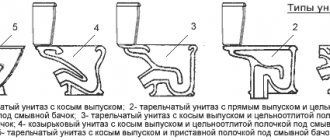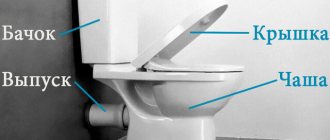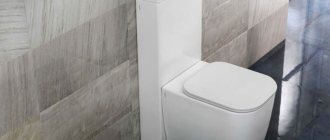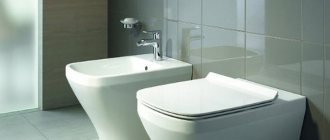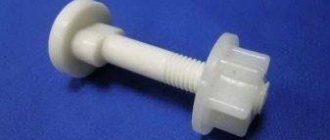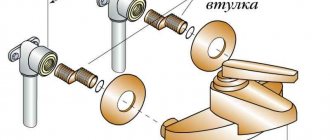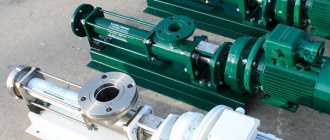Before purchasing plumbing fixtures, it is recommended that you familiarize yourself with the standard dimensions of the toilet bowl, and also determine which dimensions are suitable for your type of room. As a rule, this depends on the type of plumbing fixture and the area of the room. Wall-hung and floor-mounted types have different designs and, accordingly, different sizes of the toilet with a cistern.
The height of the toilet is the distance from the floor to the top plane of the seat, not counting the seat lid. According to the interstate standard of 2021, the height of a floor-standing toilet should be: for adults - 40 cm, for children - 33.5 cm. The standards were developed taking into account the average height and build of a person and are still relevant.
After determining the required dimensions, you can begin designing the toilet and placing plumbing fixtures in the bathroom. Craftsmen do not recommend selecting plumbing fixtures after drawing up a floor plan.
Rules for choosing toilet sizes
First of all, you need to determine the required width and length of the plumbing fixture. It is necessary to take measurements and find out the following technical parameters:
- width and length of the room. The most suitable distance is considered to be 30 cm from the toilet to other plumbing fixtures or walls, as well as 60 cm from the bowl to the wall in front;
- width and shape of the sewer outlet (oblique, horizontal or vertical pipe outlet);
- the width and length of the sewer pipe (from the wall to the pipe), on which the distance of the toilet from the wall depends;
- distance to water supply.
If a system is being installed that requires installation (for example, a hanging product or with a built-in tank), then it is necessary to additionally take into account the width, height and other dimensions of the structure. Also, we should not forget about the false wall and its decoration.
After the width and length have been selected, you should determine the height of the toilet. As a rule, the distance to the floor should be such that your legs can stand on it without strain, and not hang. It is best to calculate the height based on the tallest person living in the house.
Getting ready for installation
The base for installing the toilet must be level. There are several options for the development of events, namely:
- if the floor is tiled and does not have differences in level, we do not carry out any preliminary measures to level the base;
- If the floor is tiled and is not level, we install the toilet using choppers. To do this, holes are drilled in the floor, the choppers are driven into them at a level, and then the toilet is attached to the choppers using screws;
- if it is planned to replace the tiles, dismantle the old cladding and fill in a new screed if the old one has differences in level;
- if the toilet is installed in a new house or apartment without any finishing, fill in the screed and lay the tiles.
We pay attention to the pipes. We clean the sewer from debris and various deposits, install a tap on the water supply (if it was missing before) to shut off the water supply to the tank
Features of measurements
To ensure that the purchased plumbing fixtures can be installed without problems, it is recommended to consider the following factors:
- If there is a sewer system laid near the walls (standard option), and not in the ceilings between floors, you should buy options with an oblique pipe. Their installation is quite simple, regardless of the location of the sewer outlet;
- based on the width and length of the sewer outlet pipe, it is necessary to select a connecting collar;
- presence of a bidet;
- The flexible hose that connects the water supply and the drain tank must be short, but not hanging in the air, otherwise the water will stagnate.
When purchasing a toilet, you should take into account not only the dimensions and area of the bathroom or shower room, but also the shape and width/height of the sewer outlet. The distance from the wall to the toilet directly depends on the pipe.
It is believed that the presence of a lower type pipe requires the most effort for re-installation. In this case, reconstruction will be necessary, which will affect the flooring and wall decoration.
Therefore, before purchasing plumbing fixtures, it is important to focus on how much space the installed toilet will take up (for example, know the height of the toilet from the floor).
How to choose plumbing?
If the goal is to quickly install a standard toilet, then the choice will be floor-mounted toilets, where you won’t have to spend a lot of time on measurements or labor-intensive and lengthy installation work. The price for these models is much lower than non-suspended ones.
But if the goal is to embody modern design solutions, then hanging models will be an excellent choice.
When installing this type of toilet, you need to take into account many nuances, for example, the nozzle on the toilet bowl, because a difference of 2-3 cm that the nozzle can give usually leads to discomfort in using the model.
Types of toilets and their sizes
To begin with, it is advisable to understand the types of tanks. If the tank is not part of a monolithic structure with a toilet bowl, then it is recommended to find out the features of the various types of construction. Please pay attention to the following points:
- volume of liquid in the tank. It is advisable to choose an option with greater capacity;
- type of drain: vertical (nowadays it is almost never used, only in old houses), horizontal and oblique;
- drain mechanism material: plastic or ceramic. It is better to purchase a plastic version, because... it is not subject to corrosion;
- drain button. It is recommended to install a double button if possible. It allows you to regulate the volume of liquid drained and thus save on water consumption.
Based on the installation method, the following types of products are usually distinguished:
- monoblock – has a monolithic design. It can be used for a long period, but is often quite expensive, because such products are often designer;
- compact model - behind the toilet bowl there is a shelf on which the tank is installed using bolts. Standard sizes are usually small, so they are often installed in small bathrooms. However, during installation it is important to ensure reliable waterproofing using a gasket and a special sealant, otherwise after a few years of use the tank may begin to leak;
- suspended or built-in products with hidden communications. This option is becoming increasingly popular due to the beautiful appearance of the plumbing fixtures and high reliability. Installation of such a device is somewhat more complicated compared to other options, because you will need to place an installation - a frame on which the water tank and other elements are attached.
Floor-standing models are the most common because... In small bathrooms it is often not possible to install a wall-hung model. They vary depending on the shape of the tank and the shape of the structure. For example, corner models do not require much free space.
All plumbing fixtures are also classified by size: children's, small, medium and large. Larger toilets, if required, are in most cases made to order. In stores and other points of sale, as a rule, only products with standard sizes are presented.
█ Design. Nuances of installing a toilet. Dimensions of toilet + sink. A variety of toilets.
Corner
Corner standard appliances are quite popular among owners of small bathrooms. They visually increase the space and also allow you to hide some communications. Installation in a corner is possible due to the presence of a triangular tank.
There are 2 types of such models: monoblock design and compact. The monoblock includes a toilet bowl and a cistern. The compact model is usually installed separately. This design is suspended; the tank is placed in a standard frame installation or behind a false wall.
Advantages:
- allow you to realize any design idea in the interior, thanks to the wide variety of assortments;
- placing plumbing fixtures in the corner helps save space and place all the necessary objects;
- Most models have a built-in automatic emergency prevention system. If the tank leaks, this will avoid flooding, because liquid will flow into the overflow pipe.
The disadvantages include certain difficulties during installation. The walls on which the plumbing fixtures are mounted must be strong, because... The mass of a standard size toilet is quite large.
When calculating dimensions, it is necessary to take into account the width of the corner . Standard dimensions of a corner toilet: width from 35 to 38 cm, height from 38 to 42 cm, depth from 73 to 80 cm.
An example of marking a bathroom in a private house
Hanging
Wall-hung toilet models of standard sizes are now gaining popularity. Their design feature is that only the toilet bowl is visible to the toilet visitor.
The tank is completely hidden behind a false wall or located in a corresponding niche. This variety can increase the free space, but in fact this does not happen, because... the ceiling or wall moves forward.
The tank and other structural elements are fixed to a durable metal frame that can withstand up to 400 kg of weight. Some models have increased load capacity, they can withstand up to 800 kg. This is convenient when the structure is installed on a non-load-bearing wall.
The advantages of the hanging model include easy cleaning of the toilet, the ability to hide communications and ensure silent operation of the cistern. The dimensions of the toilet bowl are standard: the width of the toilet is from 34 to 37 cm, the height of the wall-hung toilet from the floor is 36-40.5 cm, the length is within 47-70 cm.
At the design stage, the width and height of the installation should be taken into account separately. The dimensions depend on its type and shape. Standard drain tanks, as a rule, are thin (about 90 mm) and wide (usually up to 50 cm).
Exclusive large types
In some cases, it is impossible to install an installation that can withstand heavy weight. For example, if installation on a solid wall cannot be done, then another design option cannot be chosen.
However, if there are large people in the family, it is advisable to purchase a toilet specifically designed for such purposes. Such models are not standard; they have increased dimensions and increased strength, which allows them to withstand greater loads.
Due to the increased width, height and other dimensions of a toilet with a tank, it is quite difficult to find such models on sale. In most cases, they are manufactured by specialized companies to order. To do this, you must provide the desired parameters of the design elements in order to obtain a perfectly suitable product.
Most often, plumbing fixtures sold in standard stores have the following dimensions:
- width (42-46 cm);
- height of the toilet with tank (60-68 cm);
- depth (up to 82 cm).
Built-in
Built-in toilets have the same advantages as wall-hung toilets; their sizes are also similar. All communications of built-in products are hidden behind the wall. However, such models, unlike suspended types, can be installed on the floor. There are also built-in corner and floor-mounted children's appliances.
Standard sizes for this type of toilet:
- width: 35 - 38 centimeters;
- height: 38 - 42.5 centimeters;
- depth: 48 - 57 centimeters.
When designing, in addition to the size of the built-in toilet, you should definitely take into account the depth of the wall behind which the main mechanisms will be located. In some cases, such plumbing is placed in a wall niche, and standard communications are then hidden by finishing sheets.
Disadvantages include the need for a permanent wall or niche, as well as the increased complexity of repairs. It should be noted that it is important not to make the cover panel completely blank.
Since if leaks occur, a pipeline breaks, or the integrity of the system is damaged, the structure will need to be completely dismantled and reinstalled after repair. However, despite the laboriousness of the procedure, it is possible to install a standard tank yourself with your own hands.
Children's
Of all the varieties, the most original forms are those intended for children. In most cases, they are created to resemble various animals, which suggests atypical bowl sizes.
They will differ from plumbing fixtures for adults in their reduced size, which makes it possible to install them even in small bathrooms.
Overall dimensions of this type of toilet:
- depth – 44-60 cm;
- width – 29-35 cm;
- The standard toilet height from the floor is 26-34 cm.
As a rule, the dimensions of the plumbing fixture are selected so that the child’s use is completely comfortable. Sometimes it is acceptable for a toilet to be slightly larger than necessary to ensure it can be used for several years.
Monoblock
One of the most popular varieties is the monoblock toilet. They differ from compact models in that the cistern and toilet bowl are a single ceramic module. There are no connecting parts between these elements.
The main advantage is the increased reliability of the product and the possibility of long-term operation. This is achieved largely due to the absence of connecting mechanisms that can corrode or fail.
The main disadvantage is the high price, which is explained by some manufacturing features. If a part of the internal mechanism breaks, you will need to completely replace the entire fittings, because It is almost impossible to change one element.
If such a possibility exists, experts recommend that when purchasing a toilet, you buy an additional set of internal mechanism, because after 8-12 years, when the previous fittings fail, it will be quite difficult to find a similar model.
Standard sizes on the Russian market (according to GOST):
- width – 35-38 cm;
- toilet height standard: 38-78 cm;
- length – 68-71 cm.
Compact
As a rule, in most standard apartments where the bathroom is small, a compact model is installed, because it does not require too much free space. Design Feature: The tank is attached to the bowl, thus creating a separate component.
Such installation is much easier to carry out, because there is no need to fix the toilet to the floor or the tank to the wall, and then connect them using flexible pipes.
According to Russian legislation, all dimensions of various types of plumbing equipment are regulated by the relevant GOSTs, as a result of which the sizes on the Russian and foreign markets differ. The compact toilet is manufactured in two variations: with a built-in shelf and a separate one.
Dimensions of the compact toilet with a built-in element:
- width – 37 cm;
- height – 61 cm;
- depth – 34 cm.
Dimensions of a toilet with a tank and a separate shelf:
- width – 40 cm;
- standard toilet height – 46 cm;
- depth – 36 cm.
Standard
Standard models are suitable for a person of average build in all respects. If there are no special requirements (for example, you don’t need too strong or oversized toilets) and there is a lot of free space in the bathroom, as a rule, these options are chosen.
The advantage is the absence of the need to create a niche for installing the installation (as in suspended or built-in plumbing), as well as the affordable cost.
Like compact toilets, standard products differ in the way the shelf is attached. There are options with a built-in (solid-cast) shelf and a separate one. Standard sizes:
- depth – 61 cm (with a separate element 32-47 cm);
- height – 34 cm (36 cm);
- width – 31-37 cm (30-35.5 cm).
It is worth noting that before designing a bathroom, it is recommended to choose a suitable model of plumbing fixtures so that the dimensions (width, height and length) optimally suit everyone living in the room.
Then, based on the selected product, you need to think about the placement in the room. It is also important to remember that not all plumbing fixtures have dimensions that comply with Russian GOST, so before purchasing, it is advisable to further clarify the dimensions with the seller.
Price
And now that almost everything is known about different bathroom comfort systems, we will talk about price. The difference in price for some systems with almost identical functional features can be up to 5,000 rubles.
In the first line, as always, are the works of German and Swiss companies. Frame structures from plumbing manufacturers start at 15,000 rubles, meaning a complete installation kit, including a flush button, but without a toilet.
A more modest German-made version, in which you can select the drain button separately, will cost about 8,000-9,000 rubles. The block system will cost even less, about 7,500 rubles. You can choose the equipment yourself; for example, a tank will cost from 5,000 rubles.
The most economical will be a system made from incomplete parts ; such a frame installation designer will generally cost 7000-8000 rubles, however, it will require slightly more time for fitting and installation compared to the standard version.
Installation recommendations
Experts, as a rule, identify dimensions that suit most people: 38x48x37-40 cm. However, depending on the type of product, there are different installation methods. It is important to carefully read the instructions before starting the procedure.
It is important to remember that the standard dimensions of products (depth, height and width) manufactured in different countries differ. Therefore, before purchasing, you should make sure of the exact dimensions in advance, so that there are no surprises when the plumbing fixtures are delivered.
Installation, as a rule, is not difficult (see how to install a toilet on a tiled floor); even a novice home craftsman in construction can do it correctly.
Toilet dimensions
SNiP norms 2.08.01-89
Until recently, the Russian Federation mainly used the standards of the Soviet state, which paid great attention to the construction, industrial, epidemiological and occupational safety of its citizens.
Next to the wall
Recognizing the appropriateness of the data presented in these documents, obtained not just empirically, but also on the basis of scientific research, the norms and rules were still used at the level of recommendations.
Over time, the need for the existence of such norms of a legislative nature was discovered.
The court took them into account when resolving disputes, but could also ignore them.
The creation of a state register of regulatory recommendations, norms and rules, as well as methodological guidelines led to the fact that the developed norms and rules in the field of construction, production and the national economy acquired the status of official and legally enshrined. The main condition for acceptance was compliance with the norms of Russian law.
Sufficient distance
Sanitary and hygienic standards (SanPiN) are not only not outdated, but have become even more relevant due to the deteriorating epidemiological and environmental situation. None of the adopted sets of rules, according to the laws of the Russian Federation and regulations of the Ministry of Health, should conflict with the standards of sanitation and hygiene.
Exceptions to the rules
There are exceptions to the norms that determine the optimal location of the toilet. Their presence is determined by the technical characteristics of the room.
In buildings not built according to standard designs (private houses, shops, cafes and others), the standards for the location of a sanitary facility may not be observed.
The reason for this may be: insufficient free space, the location of communications or the personal desire of the owner.
Violation of technical regulations for the location of a toilet is not a violation of the provisions of any law if this sanitary point is located in a non-state institution or outside a special purpose facility: hospital, kindergarten, school, military unit and the like. The owner of the premises is free to determine the location of the bathroom.
On the floor or above the floor
In advertising brochures talking about the advantages of wall-hung toilets, the following main points are given:
- Hanging plumbing does not interfere with cleaning , leaving the entire floor area accessible.
- It makes a compact toilet spacious , allowing you to save space due to the tank.
- It allows you to completely hide communications , thereby improving the appearance of the bathroom.
Let's try to find out how much truth there is in marketers' statements.
Free floor
The statement is true without any qualifications. Installation - the frame to which the toilet is attached is hidden behind a false wall, leaving the entire floor area accessible.
This indicates that in your bathroom there will no longer be black and damp places under the tank, that the base of the toilet bowl will not really interfere with cleaning, and to change the tiles you will not need to dismantle it. In addition: the vacated floor will give more scope to your imagination when choosing a flooring pattern.
Compactness
Console plumbing will indeed make the room more spacious, but only visually. The dimensions of a wall-hung toilet with a concealed cistern and installation are at least no smaller than the floor structure: due to the thickness of the false wall, they are likely to be larger.
See: the back wall of the toilet room will move forward by about 20 centimeters, thereby depriving you of the opportunity to use the space behind the toilet for shelves or a small cabinet.
Distance from toilet to wall in small bathrooms
In a small bathroom we value every centimeter of space, therefore, wanting to put all the necessary equipment in it, we need to carefully calculate the space and draw up a plan for the location of individual elements of furniture and plumbing.
To properly furnish a small bathroom, it is worth carrying out careful planning. A standard toilet has a length of about 70 cm. If you install a wall-hung toilet, it will protrude less, but at the same time it will stand further from the wall by the width of the installation or rack in which the pipes and cistern are hidden. Regardless of the size of the bathroom, a free space of 80 cm wide and about 70 cm long should be left in front of the toilet. In order for the plumbing fixtures to be comfortable to use, they must be at a certain distance from the walls. The required distance from them is at least 20 cm; the same distance is required for other elements of equipment.


